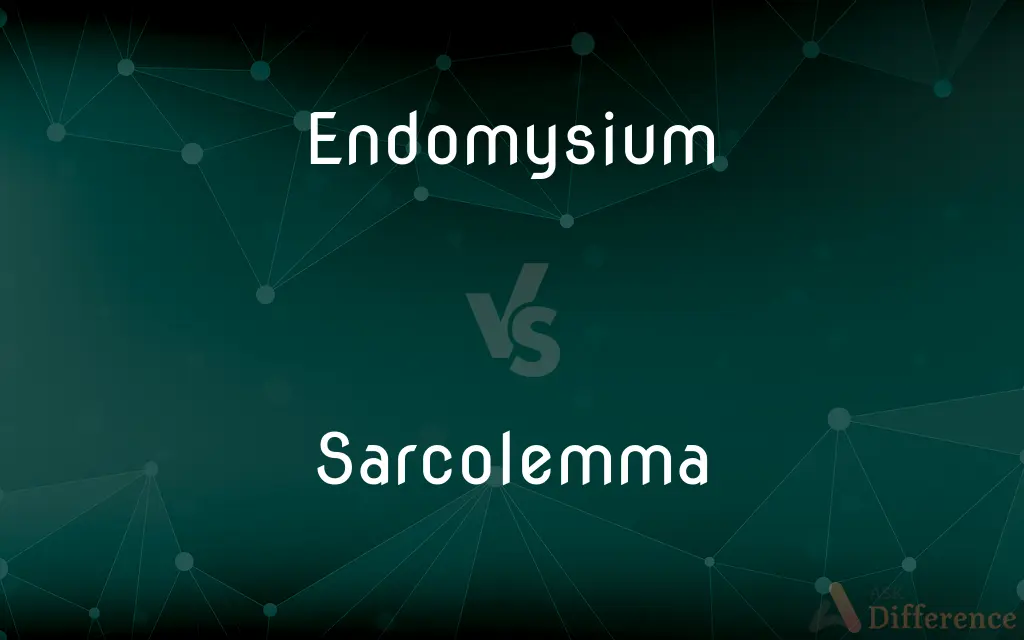Endomysium vs. Sarcolemma — What's the Difference?
By Maham Liaqat & Urooj Arif — Updated on March 20, 2024
Endomysium is thin layer of connective tissue that surrounds individual muscle fibers, provide structural support and nutrient exchange. Sarcolemma is cell membrane of a muscle fiber that encloses its contents and regulates entry and exit of substances.

Difference Between Endomysium and Sarcolemma
Table of Contents
ADVERTISEMENT
Key Differences
The endomysium and sarcolemma are both crucial components of muscle tissue, each playing a unique role in muscle structure and function. The endomysium, composed of reticular fibers, encases each individual muscle fiber, creating a supportive and nutritive environment essential for muscle function and repair. In contrast, the sarcolemma is the specialized cell membrane that surrounds each muscle fiber, akin to the plasma membrane in other cells but adapted to the specific demands of muscle cells. It acts as a barrier, maintaining the internal environment of the muscle fiber and regulating the passage of ions and other molecules crucial for muscle contraction and relaxation.
One of the distinguishing features of the sarcolemma is its association with the transverse tubules (T-tubules), which are invaginations of the sarcolemma that penetrate deep into the muscle cell. This structure ensures that the electrical impulse necessary for muscle contraction can rapidly reach the interior of the muscle fiber, facilitating a coordinated and efficient contraction response.
While both the endomysium and sarcolemma are integral to muscle function, they operate at different levels of organization within the muscle tissue. The endomysium's primary role is structural and nutritional support at the tissue level, whereas the sarcolemma's key functions involve maintaining the internal environment and facilitating contraction at the cellular level.
Comparison Chart
Definition
A thin layer of connective tissue surrounding each individual muscle fiber.
The cell membrane of a muscle fiber.
Composition
Mainly composed of reticular fibers and extracellular matrix.
Composed of a phospholipid bilayer with embedded proteins.
ADVERTISEMENT
Function
Provides structural support, houses capillaries and nerve fibers.
Encloses the muscle fiber contents, regulates substance exchange, transmits electrical signals.
Association
Encases muscle fibers within the muscle tissue.
Directly envelops the cytoplasm of a muscle cell (sarcoplasm).
Role in Muscle Contraction
Supports and binds muscle fibers, but not directly involved in contraction.
Integral to the initiation and propagation of muscle contraction signals.
Compare with Definitions
Endomysium
Connective tissue surrounding individual muscle fibers.
The endomysium ensures the structural integrity of each muscle fiber during contraction.
Sarcolemma
The cell membrane of muscle fibers.
The sarcolemma's selective permeability is crucial for maintaining the muscle cell's internal environment.
Endomysium
A supportive layer providing a nutritive environment for muscle fibers.
Capillaries in the endomysium deliver oxygen and nutrients directly to muscle cells.
Sarcolemma
Involved in the transmission of electrical impulses.
Depolarization of the sarcolemma initiates muscle contraction.
Endomysium
A component of the muscle's extracellular matrix.
The endomysium, along with the perimysium and epimysium, forms the connective tissue framework of the muscle.
Sarcolemma
Interfaces with the T-tubules for rapid signal conduction.
T-tubules, extensions of the sarcolemma, ensure that contraction signals reach deep into the muscle fiber.
Endomysium
Houses nerve endings for muscle innervation.
Nerve fibers running through the endomysium facilitate precise muscle control.
Sarcolemma
Regulates the entry and exit of ions and nutrients.
Calcium ions cross the sarcolemma to trigger muscle contraction.
Endomysium
Binds muscle fibers within a fascicle.
The endomysium's reticular fibers help to maintain the alignment of muscle fibers for efficient force transmission.
Sarcolemma
Encloses the muscle fiber's sarcoplasm.
The sarcolemma maintains the integrity of the muscle cell, enclosing its organelles and cytoplasmic components.
Endomysium
The endomysium, meaning within the muscle, is a wispy layer of areolar connective tissue that ensheaths each individual muscle fiber, or muscle cell. It also contains capillaries and nerves.
Sarcolemma
The sarcolemma (sarco (from sarx) from Greek; flesh, and lemma from Greek; sheath) also called the myolemma, is the cell membrane of a muscle cell. It consists of a lipid bilayer and a thin outer coat of polysaccharide material (glycocalyx) that contacts the basement membrane.
Endomysium
A layer of connective tissue which surrounds individual muscle fibers
Sarcolemma
A thin membrane enclosing a striated muscle fiber.
Endomysium
The delicate bands of connective tissue interspersed among muscular fibers.
Sarcolemma
(anatomy) A thin cell membrane that surrounds a striated muscle fibre.
Sarcolemma
The very thin transparent and apparently homogeneous sheath which incloses a striated muscular fiber; the myolemma.
Sarcolemma
An extensible membrane enclosing the contractile substance of a muscle fiber
Common Curiosities
Is the endomysium present in all types of muscle tissue?
The endomysium is found in skeletal muscle tissue and, in a modified form, in cardiac and smooth muscle tissues, adapted to their specific structural and functional needs.
How do the endomysium and sarcolemma interact during muscle activity?
While they function at different levels (tissue vs. cellular), both the endomysium and sarcolemma are essential for coordinated muscle function, with the endomysium providing structural support and the sarcolemma facilitating contraction signaling.
What is the primary function of the endomysium?
The endomysium provides structural support and houses capillaries and nerve fibers, facilitating nutrient exchange and neural connectivity for individual muscle fibers.
What role do capillaries in the endomysium play?
Capillaries in the endomysium deliver oxygen and nutrients to muscle fibers and remove metabolic waste, supporting muscle metabolism and recovery.
What happens if the endomysium is compromised?
Compromise of the endomysium can lead to muscle fiber damage, impaired force transmission, and reduced muscle efficiency, potentially resulting in weakness or injury.
How do diseases affecting the sarcolemma manifest in the body?
Diseases affecting the sarcolemma can result in muscle weakness, impaired contraction, and a range of muscular dystrophies, impacting mobility and quality of life.
How does the sarcolemma contribute to muscle contraction?
The sarcolemma transmits electrical signals and interacts with the T-tubules to propagate contraction signals throughout the muscle fiber, triggering the contraction process.
Can muscle function be affected if the sarcolemma is damaged?
Yes, damage to the sarcolemma can disrupt ion balance and signal transmission, impairing muscle contraction and leading to muscle weakness or dysfunction.
How does the structure of the sarcolemma differ from other cell membranes?
The sarcolemma includes specialized structures like T-tubules and has unique protein compositions to meet the demands of muscle contraction and signal transduction.
Can the sarcolemma repair itself after injury?
Muscle fibers have some capacity for repair, and the sarcolemma can undergo resealing processes after minor injuries, but severe damage might require intervention or lead to cell death.
Share Your Discovery

Previous Comparison
Ziti vs. Mostaccioli
Next Comparison
Antithesis vs. ParadoxAuthor Spotlight
Written by
Maham LiaqatCo-written by
Urooj ArifUrooj is a skilled content writer at Ask Difference, known for her exceptional ability to simplify complex topics into engaging and informative content. With a passion for research and a flair for clear, concise writing, she consistently delivers articles that resonate with our diverse audience.














































